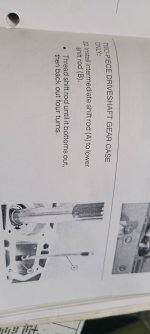Plugs: all 4 burn the same color.
Ok I took the boat out yesterday and of course the rebuilt engine was giving me issues to stay at idle while in gear. So, I readjusted the pivot throttle cam to touch the roller perfect. But then I still didn't get idle in gear so I had to adjust the throttle link bar to extend it so it can push the pivot cam farther into the roller when connected to the tower shaft. I also adjusted that engine closer to 1 &1/2 to get the carbs to not bog down when throttle was turned on. With the idle also adjusted up a lot from halfway it is now holding idle but I don't like it, don't think it is right. Remember this is a twin-engine Force 120 and if you only run one you get up to 10mph maybe. So, with both engines compensating each other I was able to get to 36Mph and 4100RPM???? showing on the good engine tach. The rebuilt one doesn't send a signal to the tachometer, so I have to check the grey wire or change the rectifier if it is not sending the pulse.
The timing is at 28BTDC, and it is what the manuals show to put it at, but the linkages and the throttle link are not adjusted right in my opinion. The linkage for the rebuilt engine remote control is way off. If I put it in reverse, it goes but I get no throttle and it sometimes dies. I have to redo the linkage from the gear shift rod, interlock lever and upper shift rod, and then the cables. I have managed to get the actual manual from my year 1990 but they don't do dual engine adjustments.
Can the timing be off based on the linkages adjustments being off? Can this affect idle in and out of gear and cause it to die. Also, the RPM is below the 4500-5000 WOT that the book mentions. So, both engines need to be adjusted right to reach that.
One time the alarm for the rebuilt engine went off from heating up at really low speed, and I did notice the nipple didn't spit any water. I let it cool down and it was fine after that. But the idle and adjustments are the problem. So, I have a new stator and trigger and a different good-looking flywheel, the modules and coils were tested on the second engine, and the 2 carbs are from the second engine where they worked fine. Compression is at 120-125 on the rebuilt engine and I didn't really get a chance to break it in because of the idle in gear issues.
Let me know if you have anything to point out. Thanks in advance.
Hey Jerry I found an old post about adjustment of the shifter. Is it valid for the 1990 Force 120? Do you still have the manual pics?
okay so i installed a diff lower unit this year because last year it would just skip and jump as it was comming in and out of gear at wot..installed the new lower unit and it would not go into forward gear untill the lever was about half way down.so i tried adjusting cables and it died..im...

forums.iboats.com
In the post the OP mentioned that the issue with the linkages made the motor die. I assume that it could also cause it to die in gear and not get proper idle adjustment and timing?





















